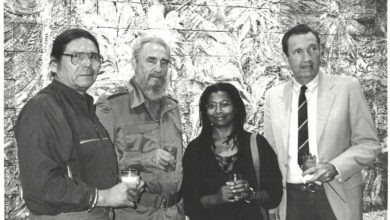On March 7, Gordon Parks, one of the 20th century’s most influential social documentary photographers, died in his home in New York City at the age of 93.
During his career, Parks was able to break into many all-white fields including the film, novel, poetry and music industries. But it is his riveting photographic images of the life of African Americans for which he will be most remembered.
Parks once said, “I chose my camera as a weapon against all the things I dislike about America—poverty, racism and discrimination.”
“I had known poverty firsthand. I learned how to fight its evil—along with the evil of racism—with a camera.”
The youngest of 15 children, Parks was born in Fort Scott, Kansas, a town he described as being “electrified with racial tension.” Soon after his mother’s death, Parks left home. He never completed high school. While working as a waiter on trains, Parks bought a cheap camera and taught himself photography.
After some success as a fashion photographer, he gained enough recognition to become the first Black photographer to join the Farm Security Administration in 1942. Part of the Roosevelt Administration’s New Deal policy, the FSA had a section of photographers assigned to documenting the grinding poverty that existed in the United States. While Parks was influenced by the work of other FSA photographers like Dorothea Lange and Walker Evans, the racial barriers he personally faced in Washington forged his social perspective.
The much-traveled Parks said that Washington, D.C. had “discrimination and bigotry worse than any place I’ve seen yet.” Parks’ benchmark photo, taken on his first day working at the FSA, was of a Black woman who had mopped the floors of government buildings her entire life. It is one of the most enduring civil rights photos of the period. The photo of Ella Watson standing in front of an American flag with a mop in one hand and a broom in the other remains a symbol of institutionalized racism in the United States. Parks entitled this image “American Gothic.”
 Gordon Parks’ famous photo “American Gothic”, 1942. Photo: Gordon Parks |
In 1944, Parks became the first Black photographer for Life magazine, the most widely read photo news weekly in the United States at the time. He soon became the most recognized photojournalist covering the emerging civil rights movement.
Parks’ work included photo essays that profiled the everyday life of a Harlem gang, as well as a series on Mohammad Ali. Having developed a level of trust with Malcolm X, Parks published a feature on the Black liberation leader. In his autobiography, Malcolm X wrote, “Success among whites never made Gordon Parks lose touch with Black reality.”
His other assignments included covering poverty in the huge Brazilian slums of Rio de Janeiro. Parks approached the project by documenting the life of one asthmatic boy named Flavio de Silva to illustrate the impoverished conditions of tens of thousands.
Switching to cinematography in 1968, Parks was the first African American to produce and direct a film for a major Hollywood studio. The movie “The Learning Tree” was based on Parks’ semi-autobiographical book with the same name. The movie merged the story of the life of a Black teenager in a rural Kansas town with the tight composition and spacing of objects that Parks had developed as a photographer. “The Learning Tree” was one of the first movies placed on the National Film Register of the Library of Congress for its historical and cultural significance.
The artistic success of “The Learning Tree” was soon eclipsed by a series of movies produced by Parks in the 1970s that took Black characters from being marginalized to occupying central roles in the films. The “Shaft” series, featuring actor Richard Roundtree, portrayed the character John Shaft as a bigger than life private detective.
Gordon Parks’ history as a filmmaker paved the way for well-known African American directors like Spike Lee, John Singleton and others.
Gordon Parks’ rich collective work will be remembered for capturing the early period of the civil rights movement and Black empowerment in the United States by the subtlety of the means that he used to expose racism.






